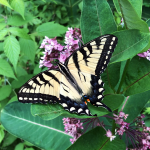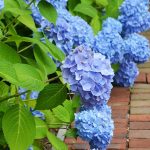Gardens
Fall Gardening Suggestions
When doing your fall garden cleanup, leave some of your seed heads and dried plant material for wildlife to use for winter food and shelter. Many butterflies and pollinators overwinter in the garden. Think of your winter landscape. Leave ornamental grasses, astilbe, butterfly bushes, sedum, and other plants standing for winter interest. It’s best not […]

Coffee By Design | Portland, Maine
Photo Credit : Katherine Keenan When doing your fall garden cleanup, leave some of your seed heads and dried plant material for wildlife to use for winter food and shelter. Many butterflies and pollinators overwinter in the garden.
Think of your winter landscape. Leave ornamental grasses, astilbe, butterfly bushes, sedum, and other plants standing for winter interest.
It’s best not to compost, but to carefully dispose of, invasive weeds; disease-prone foliage of peony, phlox, and iris; and tomato foliage that suffered blight.
Shredded leaves make great mulch. Either create a bin for collecting leaves for future use or put shredded leaves directly on your garden to protect plants from winter freezing and thawing.
Want a new garden bed next spring? First, figure out where. Then, cut the outline, and either remove the sod now, while the weather is cool and the ground is dry, or try sheet mulching: Put down cardboard and top with mulch. The sod will die over the winter, the cardboard will disintegrate, and you can plant next spring.
Store and recycle soil from your containers in a pile covered with a tarp, or in a 30-gallon container, so that you can use it again next spring: Place the used soil on the bottom and the new soil on top.
Fall is the perfect time to fine-tune your landscape. Thin out overcrowded plants, divide some of your perennials, and take advantage of end-of-the-year clearance sales at local nurseries.
Collect interesting seed pods and other dried plant materials, spray them gold or silver, and add them to your holiday décor.
When doing your fall garden cleanup, leave some of your seed heads and dried plant material for wildlife to use for winter food and shelter. Many butterflies and pollinators overwinter in the garden.
Think of your winter landscape. Leave ornamental grasses, astilbe, butterfly bushes, sedum, and other plants standing for winter interest.
It’s best not to compost, but to carefully dispose of, invasive weeds; disease-prone foliage of peony, phlox, and iris; and tomato foliage that suffered blight.
Shredded leaves make great mulch. Either create a bin for collecting leaves for future use or put shredded leaves directly on your garden to protect plants from winter freezing and thawing.
Want a new garden bed next spring? First, figure out where. Then, cut the outline, and either remove the sod now, while the weather is cool and the ground is dry, or try sheet mulching: Put down cardboard and top with mulch. The sod will die over the winter, the cardboard will disintegrate, and you can plant next spring.
Store and recycle soil from your containers in a pile covered with a tarp, or in a 30-gallon container, so that you can use it again next spring: Place the used soil on the bottom and the new soil on top.
Fall is the perfect time to fine-tune your landscape. Thin out overcrowded plants, divide some of your perennials, and take advantage of end-of-the-year clearance sales at local nurseries.
Collect interesting seed pods and other dried plant materials, spray them gold or silver, and add them to your holiday décor.







